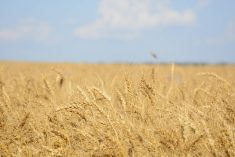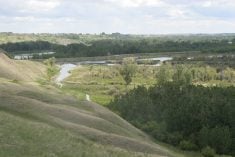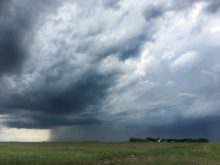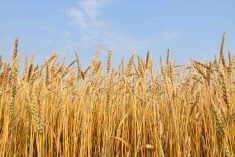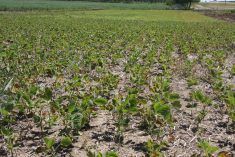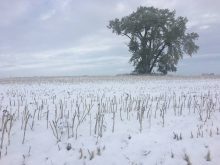Clouds are seeded with small amounts of silver iodide to reduce hailstones to pea size that will likely do less damage
Alberta farmers living between Rocky Mountain House and High River have a better than average chance that someone in their neighbourhood will suffer a devastating crop loss due to hail.
The region is known as hail alley.
Hailstorms cause major damage every year with direct costs to agriculture ranging from $50 million to $100 million per year, according to Alberta Agriculture Financial Services.
However, damage to property has surpassed agricultural losses in the last 20 years.
As property damage claims escalated, insurance companies decided something had to be done to reduce risk and major payouts. The result was a co-operative decision among insurers to form the Alberta Severe Weather Management Society, the first project of its kind in the world to be funded privately. It uses cloud seeding to reduce damage to property.
Read Also

Growing garlic by the thousands in Manitoba
Grower holds a planting party day every fall as a crowd gathers to help put 28,000 plants, and sometimes more, into theground
The program was initiated in 1996 after a severe hailstorm struck Calgary Sept. 7, 1991, with insured losses of $400 million.
“It brought the insurance companies in Alberta to their knees,” said Terry Krauss, who was with the Alberta Research Council while hail was extensively studied.
For the last five years, he has overseen cloud seeding operations on behalf of the weather management society.
“If that storm occurred today, it is estimated the damage would be more than $1 billion,” he said.
The National Research Council and the Alberta Research Council started studying Alberta hailstorms in 1957. Through a long-running meteorological research program, it confirmed that Alberta experiences a high frequency of large hail, which causes widespread damage to economically significant grain crops such as wheat, canola and barley.
At the same time, farmers pushed the government to try weather modification and cloud seeding. In 1970, with assistance from the University of Wyoming, cloud seeding was tested over the next two years.
The result was a provincially funded five-year hail suppression program starting in 1974. The program lasted until 1985.
“The historical program was funded by agriculture. We didn’t even seed storms over Calgary or Edmonton, only agriculture,” said Krauss.
The current cloud seeding project covers the area of high storm frequency in the Calgary to Red Deer corridor. Most efforts are directed at controlling hail over large population centres, but farmers on the periphery may get some benefit.
This was the 20th summer of cloud seeding in Alberta by Weather Modification Inc. of Fargo, North Dakota. It uses high-powered twin-engine aircraft to fly into forming clouds and alleviate potentially damaging storms.
Planes fly up to 18,000 feet and try to reach the earlier stages of the storm before the anvil shaped storm cloud forms.
The weather management society has its own radar station at the Olds-Didsbury airport, where it can scan a 150 kilometre radius to watch areas from Red Deer to Calgary. Twenty employees work there from June 1 to Sept. 15.
Clouds are seeded with silver iodide to reduce hailstones to pea size that will likely do less damage. Small stones may take 20 minutes to grow while the large ones could take 40 to 50 minutes.
“The main challenge with agriculture, even though the results were 20 percent reduced crop damage when we seeded, pea-sized hail can still destroy a crop,” Krauss said.
“We can’t stop pea-sized hail.”
Radar meteorologists at Didsbury decide when to start seeding and incorporate the observations of the pilots into their decisions. Flights are often launched before radar indicates a destructive storm is brewing.
“We want to seed at least 30 minutes before it hits a town or city,” Krauss said.
They also have to rely on the best weather predictions available but that never has 100 percent certainty.
“We can still not predict exactly what that storm on any given day will produce,” Krauss said.
Cloud seeding services might some day use drones, but that is at the experimental stage.
Similar cloud seeding is done in Greece, Argentina, France, Spain, Germany, China, Russia and United States to protect agriculture and property.





